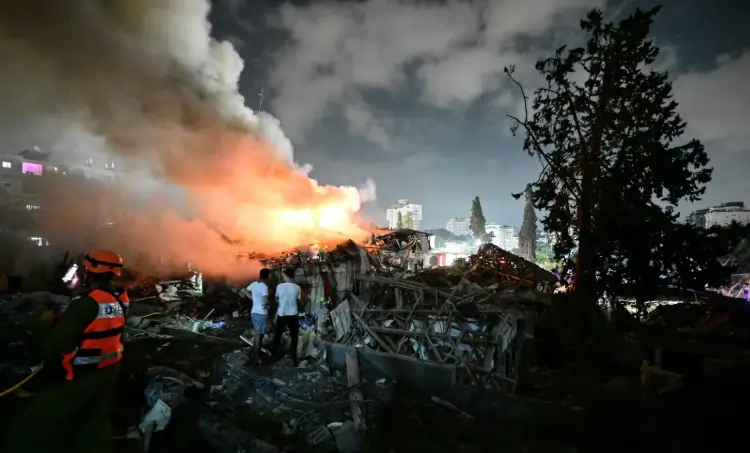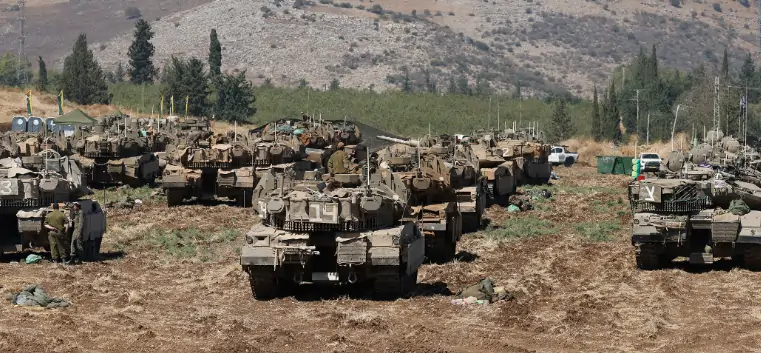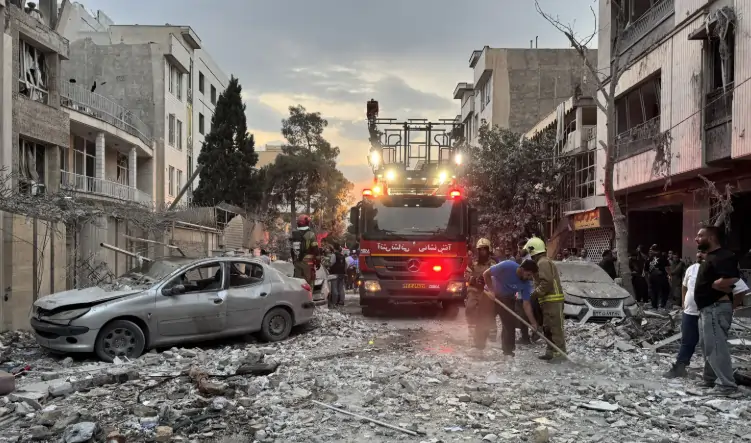
Israel and Iran War 2025: Causes, Conflicts, and Global Implications
The Middle East has once again captured global attention with the eruption of direct conflict between two regional powers: Israel and Iran. Dubbed by many as the Israel and Iran War 2025, this conflict has not only reshaped geopolitics in the region but also sent shockwaves throughout the international community. As of mid-June 2025, the situation continues to evolve rapidly, with casualties rising, diplomatic ties breaking down, and global powers scrambling for a resolution.
This article breaks down the timeline, causes, military strategies, international reactions, and possible outcomes of the Israel and Iran War 2025.

The Road to War: A Brief Timeline of Events
Prelude: Years of Proxy Conflict
Long before the open conflict, Israel and Iran had already been engaged in a shadow war through proxies. Iran’s influence in Syria, Lebanon (via Hezbollah), Iraq, and Yemen has long been a source of concern for Israel. Meanwhile, Israel’s strikes against Iranian military targets in Syria and cyberattacks on Iranian infrastructure kept tensions high for years.
Spark of War: April 2025
In April 2025, Israel conducted a high-profile airstrike near Isfahan, targeting what it claimed was a covert Iranian nuclear enrichment facility. Iran denied the presence of nuclear weapons-grade material but vowed retaliation. Days later, Iran launched a barrage of drones and ballistic missiles targeting Tel Aviv and Haifa, marking the first direct Iranian attack on Israeli territory in history.
This exchange marked the beginning of what is now being called the Israel and Iran War 2025.
Major Events So Far
May 2025: Intensification and Mobilization
By May, both nations had begun mobilizing military assets on an unprecedented scale. Israel declared a state of emergency, and Iran suspended diplomatic ties with Western nations seen as supportive of Israel. Several key developments took place:
- Israel activated Iron Dome and Arrow systems to defend against incoming attacks.
- Iran deployed its Revolutionary Guard along the western border and began missile tests in the Persian Gulf.
- Cyberattacks crippled infrastructure in both countries, including power grids and airports.
- Lebanon’s Hezbollah joined the conflict, launching rocket attacks into Northern Israel.
Early June 2025: Regional Spillover

By June 2025, the conflict had spread:
Turkey and Saudi Arabia called for emergency peace talks, while the U.S. and Russia issued stark warnings about escalation.
Iraq and Syria became battle zones, with Israeli strikes on Iran-backed militias.
The Red Sea trade route was disrupted, raising global oil prices.
Key Players and Their Roles
Israel
Israel’s military strategy has focused on:
- Preemptive airstrikes on Iranian missile sites and nuclear facilities.
- Defending civilian areas through its multi-tiered missile defense system.
- Mobilizing reservists and expanding its intelligence operations globally.
Politically, Prime Minister Benjamin Netanyahu stated that Israel “has the right to defend itself by any means necessary,” gaining wide domestic support despite international criticism.
Iran
Iran’s response has been aggressive and multi-pronged:
- Launching missile barrages at Israeli cities and military bases.
- Mobilizing Hezbollah and other regional proxies.
- Shutting down the Strait of Hormuz temporarily, threatening 20% of the world’s oil supply.
Iranian Supreme Leader Ayatollah Ali Khamenei called the war “a just resistance against Zionist aggression,” framing it as part of a larger ideological and religious struggle.
United States
The U.S. has provided logistical and intelligence support to Israel while avoiding direct involvement. U.S. President Kamala Harris has urged restraint but reaffirmed America’s “ironclad commitment” to Israel’s security.
Russia and China
Russia has called for peace but blamed the West for instigating the conflict. China, concerned about oil supply disruptions, has offered to mediate while strengthening its presence in the Persian Gulf.
The Human Cost
As of June 16, 2025, estimates suggest:
- Over 5,000 civilian casualties on both sides.
- Mass displacement in Northern Israel, Southern Lebanon, and Western Iran.
- Healthcare systems strained, particularly in Iranian border towns and Gaza.
- War crimes accusations lodged at both countries at the International Criminal Court (ICC).
NGOs have warned of an impending humanitarian crisis, especially as refugee flows increase and food supplies dwindle in conflict zones.
Cyberwarfare: The Silent Front
Aside from the military exchanges, cyberwarfare has been a crucial battleground:
- Israel’s Ministry of Defense was temporarily disabled by Iranian hackers.
- Iran’s central banking system suffered a malware attack attributed to Mossad.
- Fake news campaigns and social media manipulation have sowed public panic and misinformation.
Cyberwarfare is now considered one of the defining elements of the Israel and Iran War 2025.
International Response
United Nations
The UN Security Council held several emergency meetings but failed to pass a resolution due to vetoes by the U.S. and Russia. UN Secretary-General António Guterres called the war “an existential threat to regional and global peace.”
Arab League
The Arab League remains divided. While Saudi Arabia and the UAE have condemned both Iran’s aggression and Israel’s escalation, others like Syria and Iraq have openly sided with Tehran.
NATO
NATO is on high alert, particularly over the risk that Iran might strike U.S. bases in the region, dragging the alliance into war. However, no direct NATO intervention has occurred yet.
Economic Impact of the War
The Israel and Iran War 2025 has had a severe impact on global markets:
- Oil prices surged to over $130 per barrel, triggering inflation worldwide.
- Stock markets dipped, especially in Europe and Asia.
- Middle Eastern airlines suspended operations, affecting global travel routes.
- Shipping through the Red Sea and Strait of Hormuz has slowed, threatening supply chains.
Economists warn that if the war drags on, a global recession could follow.
Possible Scenarios Moving Forward
As the conflict deepens, analysts predict several possible scenarios:
1. Total War
If neither side backs down, the war could evolve into a regional conflict involving Lebanon, Syria, Iraq, and even Gulf States.
2. Stalemate and Ceasefire
With international pressure mounting, a temporary ceasefire could be brokered by a neutral country like Switzerland, China, or Turkey.
3. Regime Change
Should internal dissent grow in either Israel or Iran due to the cost of war, political instability could follow, especially in Iran where economic sanctions have already strained the public.
4. Nuclear Escalation
Though unlikely, there are growing fears that if the war reaches critical points, either nation may attempt to use or threaten nuclear capability. This scenario would invoke immediate intervention by the United Nations and global powers.
Public Opinion and Media Coverage
Media coverage worldwide has been intense, with hashtags like #IsraelIranWar2025 and #MiddleEastOnFire trending globally. Protests have erupted in major cities like London, Paris, and New York, calling for an end to violence and urging leaders to seek diplomacy.
In both countries, propaganda has fueled nationalistic sentiment, but underground voices—journalists, activists, civilians—continue to share uncensored accounts through platforms like Telegram and Signal.
What Can Be Done?
Experts argue that diplomatic channels must remain open, no matter how hostile the environment. Key recommendations from think tanks and conflict resolution experts include:
Pushing for a regional disarmament agreement, particularly on missile capabilities.
Third-party mediation involving countries with neutral stances.
Opening humanitarian corridors for civilians and aid.
Establishing no-fly zones under UN authority.
Conclusion
The Israel and Iran War 2025 marks a dangerous new chapter in Middle Eastern geopolitics. While previous conflicts between the two were fought through proxies and cyberspace, this war has crossed a line into full-scale military confrontation. The implications—for the region and the world—are severe and far-reaching.
With no clear end in sight, the priority now must be de-escalation, humanitarian relief, and diplomacy. The longer the conflict continues, the greater the risk of dragging the entire region—and potentially the world—into a broader war.
You May Visit:
- True Ka Jan FB Page
- True Ka Jan Tiktok Accout
- Tatlong Pilipino sa Tuktok ng Mount Everest
- Freddie Aguilar: Honoring the Life, Legacy, and Music of an OPM Legend
- BINI 4th Anniversary
- Impeachment Vs VP Sara

